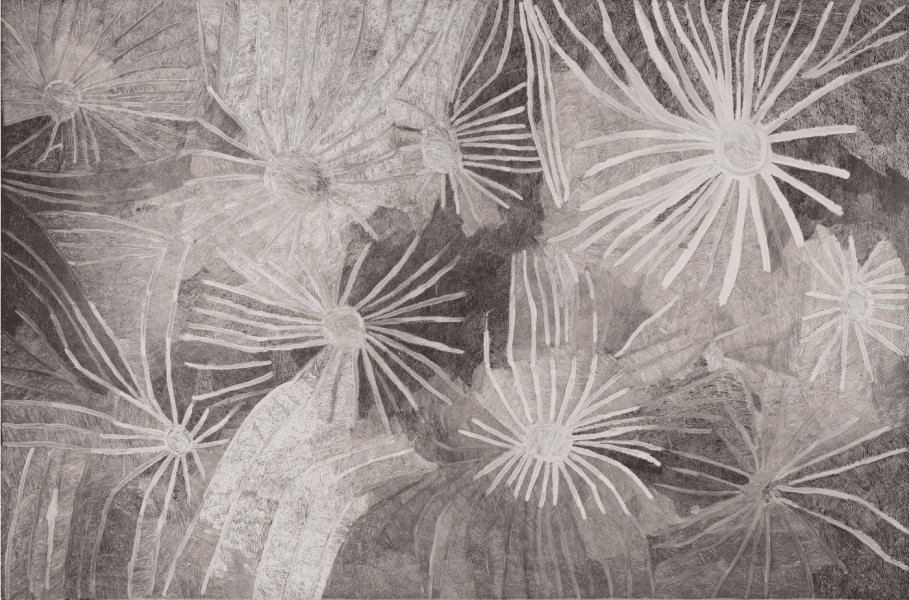
Making Space at the Table
NAP Contemporary’s group show, The Elephant Table, platforms six artists and voices—creating chaos, connection and conversation.

Nyapanyapa Yunupiŋu, Lines, 2017, natural pigments on bark, 210.0 x 113.0 cm, MAGNT Collection.

Nyapanyapa Yunupiŋu, Ganyu (Stars) 2019, detail, earth pigment on compressed fibre board, 4K digital video projection, 241.0 x 363.2 x 6.0 cm. Courtesy of the artist and Buku-Larrŋgay Mulka Centre. Kerry Stokes Collection, Perth.

Nyapanyapa Yunupiŋu, Dharpa – wild apples, 2009. Print size: 25 x 49 cm; paper size: 40 x 60 cm. Purchased 2009, Telstra Collection, Museum & Art Gallery of the Northern Territory.
Nyapanyapa Yunupiŋu’s practice defies easy categorisation. The Yolŋu artist is known primarily for her bark paintings but she has also made ghostly fields of larrakitj (memorial poles), drawn on acetate, worked in multimedia and recycled materials, and sculpted animals from beach hibiscus.
Early works drew from her life. In 2008, she won the Wandjuk Marika 3D Memorial Award in the Telstra NATSIAAs for a multimedia work about the time she was gored by a wild buffalo.
Other pieces from this time feature animals, hunting parties and a visit to Sydney, including Sydney Hotel and Wild Apple Orchard, 2008. But she soon veered in another direction, painting trees and leaves, and then non-figurative compositions, known as her mayilimiriw or ‘meaningless paintings’. Some worked in tonal variations, like Pink diptych, 2015, while others foregrounded mark-making, like Some circles, 2011, and Lines, 2017.
“It’s that defiance of expectation,” says curator Luke Scholes about the unprescribed and singular nature of Yunupiŋu’s practice. This variation is shown in the moment eternal, the first survey exhibition and major publication on Yunupiŋu’s work, and also the first survey developed by the Museum and Art Gallery of the Northern Territory recognising an Aboriginal artist. Scholes, MAGNT’s curator of Aboriginal art, says there are reasons for that, including the museum’s relatively small size and community preferences. “Quite often the art centres that these artists work for have been hesitant to identify a single artist to be recognised in this way,” he says. But he sees Yunupiŋu as one of a number of women who are demanding attention for “really singular practices… It’s become inevitable that we have to recognise these really important artists with shows like this.”
Since Incident at Mutpi (1975), 2008, the groundbreaking multimedia work about the buffalo attack, Yunupiŋu’s work has been in the Biennale of Sydney twice, the Tarnanthi festival, and the USA touring exhibition Marking the Infinite. Her work has continued to feature in the NATSIAAs too, and she won the bark painting category in 2017. Her work has ended up in private collections around the world, and the moment eternal includes a 45-panel work loaned from noted US collectors Dennis and Debra Scholl. But Scholes says that while Yunupiŋu is very aware she’s making “intercultural objects”, she is completely uninterested in the dialogues around her work. As he puts it, she prefers making art to talking about it.
This drive is behind one of the biggest innovations in her practice: her move into animation. In 2010, when there was a shortage of bark in Yirrkala, Yunupiŋu picked up what was at hand at the Buku-Larrŋgay Mulka Centre where she works. She made hundreds of drawings with paint pens on sheets of acetate. Later, with the multimedia expertise of the centre’s Mulka Project, the drawings were assembled into animations. But instead of imposing an order, an algorithm presented them in ever-changing configurations that suggested the Yolŋu idea of the ‘everywhen’, a coexisting past, present and future.
This comes out in a different way in Ganyu (Stars), 2019, a major multimedia work commissioned by MAGNT for the moment eternal. It pulls together the past and the present, the sky and the land, in a double-sided work comprising painting and animation. The painting is a large-scale work that honours the Ganyu and Garak paintings of her late sister Gulumbu Yunupiŋu. The animation on the other side has been assembled from a suite of older drawings. Scholes says it’s not about a specific place but captures a sense of the Arnhem Land country. “You go through these forests of wild apple trees and you make your way across this landscape and go down to the water,” he says. Yunupiŋu has painted the screen a textured black. “It’s not this clean projection,” says Scholes. “It feels like the bush.”
“She’s a remarkable artist with a profound capacity to innovate but also to return to past ideas, to work across different mediums, effortlessly, and to challenge our understanding—and Yolŋu’s understanding—of what her practice is and what Aboriginal art is as well,” says Scholes. “She’s turned all of that on its head.”
the moment eternal
Nyapanyapa Yunupiŋu
Museum and Art Gallery of the Northern Territory (MAGNT)
23 May–25 October
Please note that the Museum and Art Gallery of the Northern Territory’s Darwin gallery is open. With public safety in mind, physical distancing, limits to the number of people in the gallery and hygiene measures will be in place.